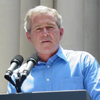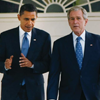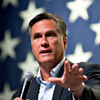Executive Onboarding Lessons from Presidential Transitions
What HR can learn from the massive government takeovers that occur whenever a new commander in chief takes office.
Introduction
Imagine what would happen if your company’s entire executive leadership and management teams up and left at the same time, handing over their badges and turning off the lights without leaving so much as a list of tips behind for the folks who would replace them. Thousands of vacancies would open up in an instant—and your HR team would have less than three months to recruit for those positions.
Mind-boggling as that scenario may seem, it is exactly what happens in the U.S. government every time a new president is elected.
U.S. presidents have 70-some days between the November election and the Jan. 20 inauguration to get their administrations in place. Within this short window—which will be 73 days in 2016-17—roughly 4,000 people must be selected across hundreds of agencies, 1,100 of whom must go through a Senate confirmation process. The president also oversees a nearly $4 trillion budget and a workforce of 2.1 million civilians and more than 2 million military personnel.
“One of the hallmarks of our nation is the peaceful transfer of power, and it’s really remarkable,” says Tina Sung, vice president of government transformation and agency partnerships at the Partnership for Public Service in Washington, D.C. “What a lot of our citizens don’t realize is a presidential transition is a time of great vulnerability because you have people with all the knowledge and expertise leaving and a whole new crowd coming in, not really familiar with the processes and what’s going on.”
Amazingly, there has been no instruction manual for how to make this transition through much of history. “What happened prior was the incoming appointees would just ask their predecessors ‘what did you do?’ and it would be oral transition more than anything,” says Sung, who also serves on the board of the SHRM Foundation. For example, the chief of staff might call up his or her predecessor and ask how that person handled certain situations, even if the two were from different political parties, she explains.
But all of that has begun to change. The Bush-to-Obama transition went particularly smoothly, and, by all accounts, the handoff of power that will begin this November may be the most seamless yet. That is thanks in part to Sung’s organization—a nonpartisan nonprofit founded in 2001 that partners with federal agencies to make government efficient and effective; it has been assisting with the transition process since 2008. Although several organizations now help facilitate the transfer of power, the Partnership for Public Service is leading the way to make sure the nation’s most important employment pipeline stays filled and functional.
In January, the Partnership created the Center for Presidential Transition, which will become the first permanent repository for documents and guidance on presidential transitions. The center will also be, among other things, a treasure trove for HR professionals who face many of the same recruiting challenges on varying scales.
For example, staff at the center recently created an online presidential transition timeline and guide with checklists, sample documents, FAQs and phased transition plans. It reads like a combination of an onboarding manual and a manual for creating an onboarding manual—and hits on many of the topics near and dear to HR, including culture, team building and legal matters.
[SHRM Members Only Toolkit: Managing the Employee Assimilation and Onboarding Process]
Unique Hiring Challenge
Beyond the 4,000 new political appointees that must be hired following each presidential election, there are approximately 7,000 career members of the Senior Executive Service, a position classification in the civil service that is somewhat analogous to general officer or flag officer ranks in the U.S. Armed Forces. Some of those individuals may get reassigned following an election, while others might be replaced; still others may leave by choice, opting not to work under an administration that doesn’t reflect their political party.
Hiring on this scale has no counterpart in the private sector, where most mass hirings target similar workers; a corporation might expand quickly and need to rapidly recruit 4,000 fast-food workers, for example. In the recruiting that follows an election, however, thousands of unique executive-level positions must be filled. It is a long, complicated process with numerous requirements.
Historically, less than 30 percent of a president’s top leadership positions are occupied by the August congressional recess.
At the highest levels of government, hiring is even more complex. For that reason, Inauguration Day often comes and goes without all roles being filled. Historically, less than 30 percent of a president’s top leadership positions are occupied by the August congressional recess, according to the Partnership for Public Service, and nearly 19 percent remain vacant during that presidency.
Through its work, the Partnership is encouraging the campaigns to have 100 of the top positions confirmed by the inauguration and 300 more by the August 2017 congressional recess. The transition team is also tasked with developing the candidate’s campaign promises into actual policy and possible legislation and agency action.
The Partnership has been working behind the scenes with the U.S. presidential campaigns all year. It offers resources to any candidate who requests guidance, although that eventually narrows to the presumptive nominees. The Partnership’s Presidential Transition Advisory Board is a who’s who of presidential transition leaders, including Josh Bolten and Thomas McLarty, former White House chiefs of staff; Michael Leavitt, chair of presidential contender Mitt Romney’s hoped-for transition process; and Clay Johnson, former executive director of the Bush presidential transition.
As for the vast number of new appointees, Sung’s team started developing a curriculum in 2013 to onboard them following the 2016 presidential election. After launching the courses early to gather feedback and tweak the program, she was surprised when federal leaders kept sending new participants—even before the election drew near.
“I thought [I was] getting ready for the next presidential wave, but the average tenure of a political appointee is only 18 to 24 months, so within a president’s term, they’re turning over,” Sung explains. “I am happily surprised that there are so many appointees coming in.” In fact, not-so-new appointees have also been taking part in the program as well, saying they wished they had it during their first 100 days on the job.
“This onboarding program definitely has legs and should last through four to eight years of a president’s term,” Sung says.
She developed the curriculum after interviewing more than 100 former appointees about what they wished they had known before entering federal service. Many of the current core courses could be the foundation of any good corporate onboarding program:
- Ethics and Optics.
- Executive Hiring Do’s and Don’ts.
- Managing the Political-Career Interface: Building a Strong Team.
- Succeeding with Execution: Driving Results and Accountability.
There are also several electives, and Sung is constantly dreaming up new ideas, based in part on the requests of participants. For example, one person suggested focusing on working with an agency’s inspector general, which can cause “real heartburn” for appointees, she says. “In the private sector, it’s not so serious—it’s like when you get a bad audit from your auditor. But in the government, it makes front-page news if the inspector general finds weaknesses in your program.”
Lessons for the Rest of Us
In the process of preparing courses and guidelines on rapid government hiring and onboarding, Sung and her colleagues offer the following tips that any HR department can use when hiring and readying top executives, whether they work with staffs of 50 or 50,000.
Build a strong foundation for your program. If you’re going to create a structured onboarding process, it can’t be a one-off, Sung says. She cites research indicating that 40 percent of all executive transitions fail in the first 18 months. The program must be well-organized and tailored to your senior team so that these new leaders know what will be happening each week.
Highlight what makes your organization unique. Don’t expect talented executives to attend generic onboarding sessions such as Leadership 101 or Management 101.
“They have to view it as an essential element, not a throwaway, and devote the time to it, including meeting with the top executives or peers,” Sung says. “It has to be a systematic process which is written down and available for everybody to see and know about.”
And don’t call it “training,” she adds. “Executives don’t go to training, but they will go to ‘onboarding.’ ”
Highlight what makes your organization unique. Don’t expect talented executives to attend generic onboarding sessions such as Leadership 101 or Management 101. Instead, zero in on your particular culture and the processes driving your organization. For example, federal government employees are unique in that they must always deal with three budgets at one time: managing the current budget, being audited on the previous year’s budget and providing input into the next fiscal year’s budget. So Sung and her team make sure to include explicit guidance related to that challenge in their materials.
Organize an introductory course. Ensure that new executives know exactly what they will learn by organizing an “orientation to the orientation”—an intro course that welcomes them to your organization and gives them a road map for their onboarding experience.
Help new leaders understand how things work in your organization by sharing tips as well as common derailers. Provide specific examples when possible. Since all company cultures are defined by an unwritten set of rules and behaviors, share your insights on what those are. Describe your organization the way you would if you were chatting casually with a co-worker over coffee.
Also keep in mind that executives often feel uncomfortable asking staff questions about how things should be run because they feel they are supposed to be in charge and have all the answers. Sung takes away some of that unease by providing leaders with a list of frequently asked questions. “You would be surprised how powerful that little one-sheeter is,” she says.
Present information in an easy-to-digest format. New leaders are frequently overwhelmed and feel as if they are trying to drink from a fire hose during their first days on the job, Sung says. Help them absorb and prioritize information by providing material on governance structures and decision-making processes and high-level summaries of critical issues.
Executives don’t have time to spend a full day or multiple days taking courses. For that reason, Sung whittled down a federal budget course to 75 minutes to cover the essential elements. If participants want to learn more, they can attend follow-up “nuts and bolts” courses.
“When I do my sessions, I run a big roundtable with 25 or 30 people; they’re talking to a peer, and they’re able to ask all their questions,” she says. “I don’t give them all the PowerPoint. … I’m designing it so they can learn and work at their pace, and of course the escape valve is they can always ask for more.”
Focus on connections as well as content. Help new executives by connecting them to people they can collaborate with and rely on. Bring them together in a safe environment outside of their specific departments where they can ask questions and share ideas. In addition, be sure to offer ongoing opportunities for learning and engagement during each executive’s first year. These opportunities might include courses in new technology, “hot topic” roundtables or meetings of same-level managers across departments.
Connecting new executives with mentors can also be helpful. Sung oversees a program called SAGE—Strategic Advisors to Government Executives—for federal C-suite executives to seek counsel from their predecessors or private-sector counterparts. The mentors have even attended meetings with the new executives so both sides could later debrief on how the leader ran or participated in the meeting. “It’s designed to be proactive in helping somebody succeed,” she says.
Leverage your existing team. Seasoned members of your staff can serve as the bridge between leadership teams. Work with them to transfer knowledge to new executives and ensure that the work of your organization continues full speed ahead.
Choose the right “faculty” for learning. Sung does not use professors or consultants when preparing her onboarding courses and materials. “I only use practitioners who have walked in their shoes, and that has immense credibility with my appointees because they’re not—at least for my work—there to learn theory and they’re not there to be lectured at. They’re there to get honest advice,” she says.
These individuals should not only know the material well but also be able to facilitate meaningful dialogue. They should serve as role models of the kind of culture and competencies expected in new appointees.
Evaluate, test and tweak. As HR professionals develop or modify existing executive onboarding programs, it’s important to continually evaluate the content and take steps to improve upon it. The goal should be to set the person up to succeed as quickly as possible. “You want them to be productive and want them to achieve the mission,” Sung says.
Fortunately, that advice holds true whether you’re hiring a commander in chief or a chief executive officer.
Melanie Padgett Powers is a freelance writer and editor in the Washington, D.C., area.
Illustration by Doug Chayka for HR Magazine.
Managing the ChaosThe U.S. presidential transition has often been a chaotic and adversarial process—but there’s reason to believe better days are ahead. | |
 | 2000-01 |
 | Post-Sept. 11 In the wake of the worst terrorist attacks in U.S. history, President George W. Bush aims to change how presidents transition in the 21st century, recognizing that starting from scratch every four or eight years leaves the country vulnerable. |
 | 2007-08 Unlike with previous transitions, the Bush administration provides Barack Obama’s team with detailed reports on policy issues and agency work plans in advance of the takeover. The two sides even collaborate on a tabletop terrorism exercise in the Situation Room a week before Obama’s inauguration, according to an April 2016 New York Times article. |
 | 2010 The nonprofit organization Partnership for Public Service releases its first Ready to Govern report with recommendations for smoother presidential transitions. That leads to the Pre-Election Presidential Transition Act of 2010, which provides funding for transitions and authorizes the General Services Administration to provide office space for transition teams. |
 | June 2012 Presidential contender Mitt Romney collaborates with the Partnership for Public Service to start planning a presidential transition—but, alas, this change in power was not to be. |
 | March 2016 A new federal law sets up transition councils and identifies federal agency leaders responsible for transition planning. The Partnership for Public Service is encouraging changes in the Senate confirmation process to speed up approval of 1,100 appointees. |
 | 2016-17 This year, Hillary Clinton and Donald Trump’s teams both began prepping for a transition earlier than any candidates in previous presidential elections. Each is creating a detailed transition strategy, right down to a mock White House floor map. One of them will not have to use it. |


